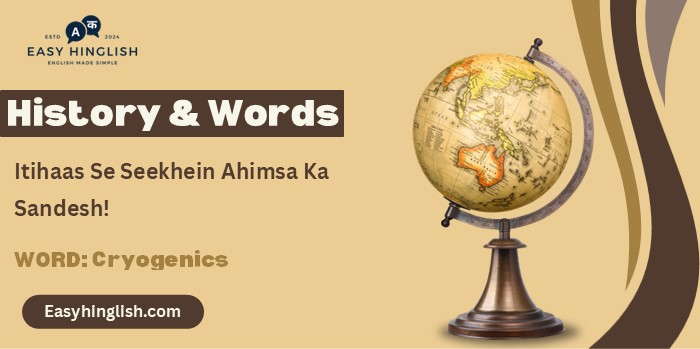History & Words: 'Cryogenics' (October 19)
Welcome to 'History & Words.' Main Prashant hoon, Wordpandit aur Learning Inc. Network ka sansthapak. Yeh series meri bhasha seekhne ki lagan aur itihas ke prati ruchi ka sangam hai. Har kadi ek shabd aur uss se judi ek tithi par roshni daalti hai, jisse aapka shabdkosh badhta hai aur aap itihas ko gehraai se samajh paate hain. Aaiye, iss safar mein shabdon ke madhyam se samay mein pichhe chalein.
🔍 Word of the Day: Cryogenics
Pronunciation: /kraɪəˈdʒɛnɪks/ (kry-uh-JEN-iks)
🌍 Parichay (Introduction)
19 October 1901 ko Paris ki clear autumn sky mein history ka most spectacular aerial display unfold hua. Alberto Santos-Dumont, ek Brazilian aviation pioneer, ne apne airship No. 6 mein Eiffel Tower ke around flight complete ki 29 minutes 30 seconds mein. 100,000 spectators ne breathless watch kiya as he navigated around 320-meter iron giant aur safely returned to starting point.
Yeh achievement sirf aviation milestone nahi thi – yeh cryogenics ka first practical application tha transportation mein. Santos-Dumont ne liquid hydrogen use kiya enhanced buoyancy ke liye, extremely low temperatures maintain kar ke. Cryogenic technology – science of extreme cold – ne flight possible banaya jo previously impossible lagti thi.
October 19, 1901 cryogenics ko laboratory curiosity se practical innovation mein transform kar diya. Yeh day marked beginning of cryogenic applications jo aaj space exploration, medical technology, aur quantum computing mein essential hain.
🌱 Shabd ka Utpatti (Etymology)
"Cryogenics" Greek words "kryos" (frost, cold) aur "genos" (born, produced) se bana hai – literally meaning "born from cold" ya "produced by freezing". Term 1950s mein popular hua jab low-temperature physics distinct field ban gayi.
Scientific context mein cryogenic wo temperatures hote hain jo -150°C (-238°F) se neeche hote hain. Absolute zero (-273.15°C ya -459.67°F) theoretical limit hai jahan molecular motion completely stops – ultimate cold.
Early terminology mein "frigorific" aur "refrigeration" use hote the, lekin cryogenics specifically ultra-low temperatures refer karta hai jahan matter ke properties fundamentally change ho jaate hain.
📖 Mahatvapurn Shabdavali (Key Vocabulary)
- 🔑 Liquefaction: Gas ko liquid mein convert karne ka process through cooling
- 🔑 Superconductivity: Electrical resistance ka complete disappearance at low temperatures
- 🔑 Absolute Zero: Theoretically lowest possible temperature (-273.15°C)
- 🔑 Boiling Point: Temperature at which liquid becomes gas
- 🔑 Phase Transition: Matter ka ek state se doosre mein change
🏛️ Itihasik Sandarbh (Historical Context)
Cryogenics ka development 19th century mein industrial revolution ke saath parallel chala. Michael Faraday ne 1820s mein first gas liquefaction experiments kiye. James Dewar ne 1890s mein liquid hydrogen produce kiya, jo Santos-Dumont ke experiments ka foundation bana.
Aviation history mein Santos-Dumont unique position hold karta hai. Wright Brothers airplane par focus kar rahe the, jabki Santos-Dumont dirigible balloons aur airships perfect kar raha tha. His approach hydrogen gas ke advanced manipulation par based thi.
Liquid hydrogen normal hydrogen gas se much denser hai, greater lift provide karta hai. Lekin challenge tha -253°C temperature maintain karna flight ke during. Santos-Dumont ka innovation portable cryogenic system develop karna tha jo airship mein work kar sake.
Deutsch de la Meurthe Prize 100,000 francs ka reward tha anyone ko jo Eiffel Tower ke around controlled flight kar sake. Previous attempts failed the kyunki wind conditions aur precise maneuvering extremely difficult tha early airships ke liye.
Santos-Dumont ka success precise engineering aur innovative use of cryogenic principles ka result tha. His airship hydrogen ko optimal density maintain kar raha tha constant temperature control through.

⏳ Samayrekha (Timeline)
- 1823: Faraday liquefies chlorine, beginning of gas liquefaction
- 1877: Louis Paul Cailletet liquefies oxygen
- 1898: James Dewar produces liquid hydrogen
- 1901: Santos-Dumont's successful flight using cryogenic technology
- 1908: Heike Kamerlingh Onnes liquefies helium
- 1911: Discovery of superconductivity
- 1957: Launch of Sputnik using cryogenic rocket fuel
- 1960s: Cryogenic preservation research begins
🌟 Is Din ka Mahatva (The Day's Significance)
October 19, 1901, 2:30 PM – Santos-Dumont ne Aero Club de France ke officials ke saamne takeoff kiya Saint-Cloud se. Airship No. 6 33 meters long aur 6 meters diameter ka tha, 3-horsepower engine se powered.
Challenge simply flying nahi tha – precision navigation tha. Eiffel Tower around flight means exact distance calculation, wind compensation, aur perfect timing. Cryogenic system ne constant buoyancy provide kiya despite temperature fluctuations during ascent aur descent.
11 minutes mein Santos-Dumont Eiffel Tower reach kar gaya, carefully navigated around its iron structure avoiding collision. Tower ke around complete circle 8 minutes mein accomplish kiya. Return journey equally challenging tha headwinds ke against.
Landing perfectly executed tha original starting point par exactly 29 minutes 30 seconds baad. Prize committee officially confirmed success – first controlled, sustained flight around predetermined course.
Crowd reaction euphoric tha. Newspapers compared Santos-Dumont to ancient heroes. Scientific community equally excited tha cryogenic applications ke potential ko seeing.
Immediate impact aviation industry par profound tha. Other inventors cryogenic techniques adopt karne lage better performance ke liye. Liquid oxygen aur liquid hydrogen rocket propulsion ke early experiments mein use hone lage.
Long-term significance space age mein clear ho gaya. Modern rockets cryogenic fuels use karte hain maximum efficiency ke liye. Saturn V, Space Shuttle, Falcon Heavy – sab cryogenic technology depend karte hain.
💬 Prasiddh Ukti (Quote)
"The air is an ocean, and we are learning to navigate it."
— Alberto Santos-Dumont (after his successful flight, 1901)
🔮 Aaj Ka Matlab aur Chintan (Modern Usage and Reflection)
Modern cryogenics revolutionary applications mein used hai. MRI machines liquid helium use karte hain superconducting magnets ke liye. Cryonic preservation theoretical possibility hai future revival ke liye, though scientifically unproven.
Space exploration entirely dependent hai cryogenic technology par. Liquid oxygen aur liquid hydrogen most efficient rocket propellants hain. James Webb Space Telescope cryogenic cooling use karta hai infrared observations ke liye.
Quantum computing cryogenic temperatures require karta hai quantum states maintain karne ke liye. IBM, Google, Microsoft quantum computers millikelvin temperatures par operate karte hain.
🏛️ Virast (Legacy)
Santos-Dumont ka October 19, 1901 ka achievement cryogenics ko practical field establish kar diya. Aviation industry ne cryogenic principles adopt kiye fuel efficiency aur performance ke liye.
Modern applications far beyond original aviation context hain: medical imaging, particle accelerators, food preservation, industrial processes – sab cryogenic technology use karte hain.
🔍 Tulnatmak Vishleshan (Comparative Analysis)
1901 mein cryogenics experimental novelty thi limited practical applications ke saath. Today yeh essential technology hai multiple industries mein. Early focus liquefaction par thi, modern focus superconductivity, quantum effects, aur precision applications par hai.
Cost aur accessibility dramatically improved hai. What required specialized laboratories 1901 mein, now commercially available hai industrial applications ke liye.
💡 Kya Aapko Pata Hai? (Did You Know?)
🎓 Antim Vichar (Conclusion)
October 19, 1901 ne cryogenics ko science fiction se scientific reality mein transform kar diya. Santos-Dumont ka historic flight ne prove kiya ki extreme cold practical applications mein harness ki ja sakti hai. Today cryogenics cutting-edge research se lekar everyday medical procedures tak essential hai. His legacy reminds us ki scientific curiosity aur practical innovation together impossible ko possible bana sakte hain.
📚 Aage Padhne ke Liye (Further Reading)
- 📘 Wings of Madness: Alberto Santos-Dumont and the Invention of Flight – Paul Hoffman
- 📗 Introduction to Cryogenic Engineering – Thomas M. Flynn
- 📙 The Quest for Absolute Zero: The Meaning of Low Temperature Physics – Kurt Mendelssohn








